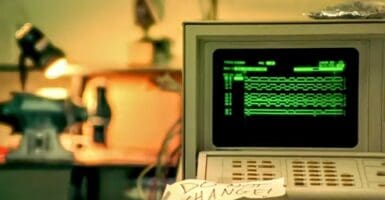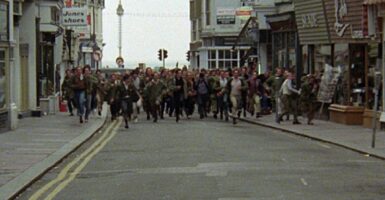Christopher Nolan Had To Dumb Down Interstellar For This Reason
This article is more than 2 years old
Christopher Nolan’s Interstellar is getting so close we can practically taste the space adventure. Hardly a day will pass between now and November 7, when the film opens, that we won’t see something about it, and today is no exception. Not only are there two fantastic new TV spots to gawk at, Nolan talked about the need to simplify and “dumb down” the original version of the script.
Set in the near future, Interstellar paints a picture of a world where climate change has progressed to the point where continued existence on Earth is no longer a viable option. As a result, a group of explorers blast off through a newly discovered wormhole in search of a fresh, habitable planet to call home. This is where the “Next Step” of this first new spot comes in, and that is one hell of step. You might even call this a leap.
The film is full of big themes and ideas, like the future of the human race, our place in the cosmos, family, and many more, but there’s also a large scientific quotient, and as a stickler for realism, Nolan brought in noted astrophysicist Kip Thorne as a technical advisor in these matters. With wormholes and black holes, there is all kinds of theoretical physics involved with what we see onscreen (check out this cool feature about how they visually created these phenomena), much of which will go over the head of average viewers. It’ll sure as shit go over mine.
The original draft of the script was apparently so heavy on these elements that Nolan had to do some cutting to, one, make it filmable, and two, make it engaging. Talking to THR he says:
Kip’s research into the mathematical possibility of wormholes, the fact they can exist, gives you a way that this could happen and was essential to the jumping-off point in the story. When I came to the project, [Kip] and Jonah had worked on a vast array of ideas involving a lot of the different things you’re talking about. And one of the most important parts of my job was to say: ‘OK, we can’t use all of this. I’m going to have to choose.’
If you read this and you’re let down a little that this may not be super hard theoretical sci-fi, I don’t think you have anything to worry about. Nolan is never one to skimp on this kind of thing, just look at Inception. You can rest assured that there is going to be some intense science involved (many early reviews have compared the content to both Robert Heinlein and Kubrick’s 2001), but Nolan is also a wonderful narrative designer, and wants to tell an engaging story (this is also said to be his most personal film to date). I think we should have faith that he’ll find a way to balance these two sides of the film. He certainly has the space for both, as the film is 169-minutes long, a full hour of which is filmed in IMAX.
The explorers, including Matthew McConaughey and Anne Hathaway, are certainly embarking on a hazardous mission, and calling this TV spot “Risk” isn’t much of a stretch. But the emphasis of this short collection of footage isn’t necessarily the journey, choosing instead to focus on what these pioneers leave behind. Family plays a huge part in the film, and that is on full display here.












